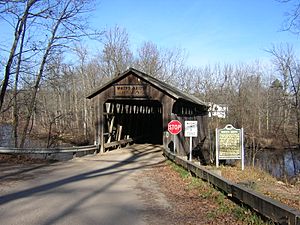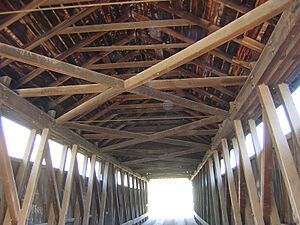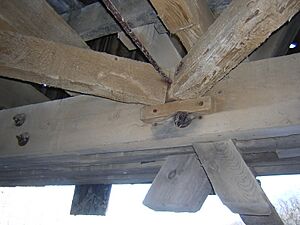Whites Bridge facts for kids
Quick facts for kids Whites Bridge |
|
|---|---|

South Approach
|
|
| Coordinates | 43°00′54″N 85°17′57″W / 43.01513°N 85.29913°W |
| Carries | Whites Bridge Road |
| Crosses | Flat River |
| Locale | Smyrna, Michigan |
| Maintained by | Ionia County Road Commission |
| Characteristics | |
| Design | Brown truss Covered bridge |
| Total length | 120 ft |
| Width | 1 lane, 14 ft |
| Longest span | 116.5 ft |
| History | |
| Opened | 1869 or 1867 |
| Closed | 2013, Destroyed by fire |
| Statistics | |
| Toll | No |
| Designated: | February 17, 1965 |
Whites Bridge is a famous covered bridge in Michigan, United States. It is 120 feet (37 meters) long and crosses the Flat River near a town called Smyrna. The bridge is known for its special design, called a Brown truss.
The original Whites Bridge was built in 1869. Sadly, it was completely destroyed by a fire in 2013. Police believed the fire was set on purpose. But don't worry! A new, exact copy of the bridge was built and opened in April 2020. This new bridge helps people cross the Flat River on Whites Bridge Road, just like the old one did.
Contents
A Look Back: History of Whites Bridge
Whites Bridge was not the first bridge in this spot. People had been crossing the Flat River here for a long time, even before bridges existed. This crossing point was called a ford. The names "Whites Bridge" and "Whites Crossing" come from the White family, who were important pioneers in the area.
Early Bridges at the Crossing
The very first bridge was built in 1840 by Levi T. White and his sons. It was a simple bridge made of logs, known as a corduroy bridge.
Around 1856, a second bridge was built. It cost about $250. But in the spring of 1869, this bridge was destroyed by a big ice jam in the river.
Building the Famous 1869 Bridge
After the second bridge was destroyed, the people of Smyrna needed a new one. They hired Jared N. Bresee and Joseph H. Walker to build it. These builders also constructed the nearby Fallasburg Bridge.
The new bridge was built very quickly, in just 84 days! Only people and animals were used to build it. The builders even used some recycled wood to save money. This bridge was very well made and lasted for many years.
A Michigan Landmark
Whites Bridge became a very important historical site. On February 17, 1965, it was added to the Michigan State Register. It also received a special Michigan Historical Marker on July 2, 1965.
Until 2013, Whites Bridge was thought to be the oldest covered bridge in Michigan that still used parts of its original structure.
The Fire and Rebuilding
On July 7, 2013, a terrible fire destroyed Whites Bridge. Investigators quickly suspected that someone had started the fire on purpose. It was a sad day for the community.
Bringing the Bridge Back to Life
After the fire, many people wanted to rebuild the bridge. On April 16, 2015, the Whites Bridge Historical Society announced that they had raised enough money. They received a large grant from the Michigan Department of Transportation and many donations from people.
By July 2016, they had over $475,000! This money allowed them to build an exact copy of the old bridge. On April 11, 2020, the Society announced that the new bridge was finished. Now, cars can drive across it once again!
Historical Marker Text
The historical marker at the bridge site tells its story:
This picturesque covered bridge, one of the last of its kind in Michigan, was built in 1867 by Jared N. Brazee and J. N. Walker, builders of several covered bridges in this area. The name of the bridge derives from the White family, a prominent pioneer family. The crossing of the Flat River here was known as White's Crossing before the first primitive bridge was built. In 1840, a bridge of log corduroy construction was erected. It was replaced by this covered bridge, costing $1700. It is of the through-truss type with a gable roof. The hand-hewn trusses are sheeted over with rough pine boards. Wooden pegs and handcut square iron nails are used to secure the various parts of the bridge. White's Bridge has been in constant use since 1867, proof that it was well made.
How the Bridge Was Built: Design
Whites Bridge used a special building method called the Brown truss system. This system was invented by Josiah Brown in 1857.
Understanding the Brown Truss
Imagine a series of "X" shapes inside the bridge. The Brown truss uses diagonal beams that push against each other. It also has almost vertical pieces that pull upwards. This design is similar to another system called the Howe truss.
The Brown truss was special because it used less wood and almost no metal, except for bolts to connect the pieces. This made it lighter and quicker to build.
Brown Truss in Michigan
The Brown truss system was popular for a short time in Michigan. It was used successfully in at least four covered bridges in the state. Two of these bridges, the Ada Covered Bridge and the Fallasburg Bridge, are still standing today. However, this design did not become widely used in other places.
Bridge Structure
The bridge rested on strong foundations made of concrete and fieldstone at each end. Like most covered bridges, it had a frame structure with a pointed roof. The roof was covered with special shingles.
The main parts of the bridge, called trusses, were covered on the outside with rough pine boards. The floor of the bridge was 14 feet (4 meters) wide and 117 feet (36 meters) long.
Originally, all the wooden parts were shaped by hand. They were held together with wooden pegs and hand-cut square iron nails. Over time, the bridge was made even stronger with extra supports.
Images for kids






